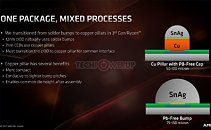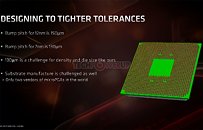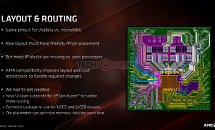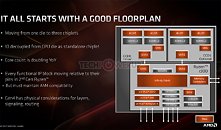Wednesday, June 12th 2019

AMD Ryzen 3000 "Matisse" I/O Controller Die 12nm, Not 14nm
AMD Ryzen 3000 "Matisse" processors are multi-chip modules of two kinds of dies - one or two 7 nm 8-core "Zen 2" CPU chiplets, and an I/O controller die that packs the processor's dual-channel DDR4 memory controller, PCI-Express gen 4.0 root-complex, and an integrated southbridge that puts out some SoC I/O, such as two SATA 6 Gbps ports, four USB 3.1 Gen 2 ports, LPCIO (ISA), and SPI (for the UEFI BIOS ROM chip). It was earlier reported that while the Zen 2 CPU core chiplets are built on 7 nm process, the I/O controller is 14 nm. We have confirmation now that the I/O controller die is built on the more advanced 12 nm process, likely GlobalFoundries 12LP. This is the same process on which AMD builds its "Pinnacle Ridge" and "Polaris 30" chips. The 7 nm "Zen 2" CPU chiplets are made at TSMC.
AMD also provided a fascinating technical insight to the making of the "Matisse" MCM, particularly getting three highly complex dies under the IHS of a mainstream-desktop processor package, and perfectly aligning the three for pin-compatibility with older generations of Ryzen AM4 processors that use monolithic dies, such as "Pinnacle Ridge" and "Raven Ridge." AMD innovated new copper-pillar 50µ bumps for the 8-core CPU chiplets, while leaving the I/O controller die with normal 75µ solder bumps. Unlike with its GPUs that need high-density wiring between the GPU die and HBM stacks, AMD could make do without a silicon interposer or TSVs (through-silicon-vias) to connect the three dies on "Matisse." The fiberglass substrate is now "fattened" up to 12 layers, to facilitate the inter-die wiring, as well as making sure every connection reaches the correct pin on the µPGA.
AMD also provided a fascinating technical insight to the making of the "Matisse" MCM, particularly getting three highly complex dies under the IHS of a mainstream-desktop processor package, and perfectly aligning the three for pin-compatibility with older generations of Ryzen AM4 processors that use monolithic dies, such as "Pinnacle Ridge" and "Raven Ridge." AMD innovated new copper-pillar 50µ bumps for the 8-core CPU chiplets, while leaving the I/O controller die with normal 75µ solder bumps. Unlike with its GPUs that need high-density wiring between the GPU die and HBM stacks, AMD could make do without a silicon interposer or TSVs (through-silicon-vias) to connect the three dies on "Matisse." The fiberglass substrate is now "fattened" up to 12 layers, to facilitate the inter-die wiring, as well as making sure every connection reaches the correct pin on the µPGA.




44 Comments on AMD Ryzen 3000 "Matisse" I/O Controller Die 12nm, Not 14nm
That is a complex layout with all the routing of differential/single ended lines many of them being impedance controller and one can also see the length matching paterns.
In other thread about x570 mainboards, there was discussions about number of layers used in mainboards. When one looks at the routing inside the processor die it is hard to image that mainboard designers can use 6 layer stackup to rout all theses signals from below the processor on only six layer PCB in mainboards.
It's like an entire motherboard has been downsized to the shape of a CPU.
In the past we had the CPU core (and that's ALL the CPU was), with a front side bus and that's it. Everything else (memory controller, I/O, signaling etc.) was done by the "north bridge", far, far away from the CPU core.
Now we're back to that topology, except that the north-bridge is 1cm away from the CORE(s), on a much, much faster interconnect than was possible before.
I can imagine future sockets of future CPUs integrating so much that the motherboard will be simply a board with slots and sockets for stuff (+ power delivery), existing only because the physical space is needed. But most if not all the electrical connections would go to the SoC.I somehow have the feeling that that fan is PWM controlled with 0db mode.
So, it would only spin up if the X570 chip actually needs the heat removed... for example when transferring large amounts of data or using multiple USB 3.2 10gb ports.
Very likely in PCI-e 3.0 mode it wouldn't spin at all most of the time.
Guess we'll see soon enough.
PCI-E 4.0 does'nt offer that much of a "extra" gain compared to 3.0. AMD said this in their own presentation. No need to jump to PCI-E 4.0 and put in a 4.0 capable card. It wont do much compared to PCI-E 3.0. What's more interesting is booting up the default PCI-E clocks from 100 to 120MHz for example.
In that case it would be hard to use tall heatsink like we used to do 15 years ago due lengthy GPUs nowdays.
Back those days I hated these noisy small fans.
Zalmann used to offer nice after market chipset heatsinks but they were quite tall. I used to own one like this one back then: :p
will be a bit flimsy but will be passive.
Edit:
TheLostSwede
OMG this is not a cooler- this is ART!.
Edit 2: Looks like they mad a better one later on-I miss this days, not like the lame ALU blocks :-:)
v1.overclex.net/hardware/257/13/cartes-meres/7-cartes-meres-P45#
www.notebookcheck.net/Intel-doesn-t-think-PCI-Express-4-0-is-a-big-deal-and-has-the-numbers-to-prove-it.423772.0.htmlBetter, most likely, but not as wacky or weird...
How low can Intel go ?
the memory controller, pci-e controller and enough pci-e 4.0 lanes for a 16x vga, nvme and sata drives and usb controller for usb ports and there are still a few free pci-e lanes left for pci-e 1x slots for sound card or sata controller if needed. :confused:
- 2 SATA ports OR 4 PCI-e lanes (1 single NVMe drive), so no more SATA at all if you use one single NVMe drive)
- 2 USB 3.1
- 16 PCIe lanes for GPU
- Audio chip link.
+ 4 free PCI-e lanes which work together.
So what are you going to do with those ?
- Network ? Then you won't have any extra USBs
- USBs? Then you won't have any SATA... or network, or wifi, or anything else
- SATA? Then give up on USBs and the rest...
Obviously all these options are very bad, so you need a device that gets 4 lanes in and a whole bunch of lanes out + other ports (USB, SATA, etc.)
That's what the chipset/south bridge does... and in case of amd's X370, X470, X570... that's A LOT of stuff which it offers, even more than Intel ones.
And it works because it's extremely rare that all of the devices will communicate all at once, so the 4 lanes between CPU and SB are more than enough.
I did manage however to overload them by copying from 4 SATA SSDs to NVMe drive and from network to USB 3.1 external drives all at once. (Intentionally overloading the south bridge) But that's an extremely rare use case.
New chipset driver for Gigabye X570 is out- who can test if it helps with win 1903?
download.gigabyte.us/FileList/Driver/mb_driver_606_asetup.exe_19.10.08_whql.zip
Also print-screens of Ryzen 5 3600 with 4266Mhz Ram from the manual of the board